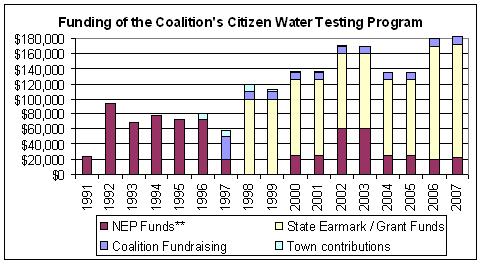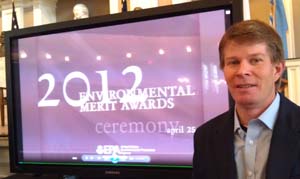Related Pages: Nitrogen Management Tools | Subwatershed Data | Massachusetts Estuaries Project | Coalition State of the Bay Reports
Background and Origins of the Program
The Buzzards Bay volunteer-based water quality monitoring program, was initially jointly implemented by the Coalition for Buzzards Bay (now called the Buzzards Bay Coalition) and Buzzards Bay National Estuary Program in the spring of 1992. The program was designed by Dr. Joe Costa and Dr. Brian Howes to address the need to monitor and evaluate nitrogen impacts to coastal waters as outlined in the Buzzards Bay Comprehensive Conservation and Management Plan. The Buzzards Bay nitrogen monitoring assessment approach was formulated in 1990 and 1991, and was articulated in this 1992 publication: Costa, J. E., B. L. Howes, A. Giblin, and I. Valiela. 1992. Monitoring Nitrogen and indicators of nitrogen to support management action in Buzzards Bay, p. 497-529. In McKenzie et al. (eds.) Ecological Indicators, Elsevier, London. The first Baywatchers Report was published in 1992 (read the 1992 Baywatchers Report, 850 kb pdf). The first compilation Baywatchers report was the 1996 Citizen’s Water Quality Monitoring Report. The first QAPP for the effort at at this link: 1994 Quality Assurance Plan (pdf).
The volunteer program measures dissolved oxygen concentrations with Hach KitsTM, secchi depth, salinity, and temperature approximately 15 times between June 1 and September 30. The volunteers also collect 2-4 water samples during summer, which we analyze for dissolved, and particulate organic nitrogen, nitrate + nitrite, ammonia, orthophosphate, and chlorophyll. The samples are analyzed by Howes’ laboratory at the UMass SMAST program, using the methodologies are described by Howes and Goering (1994).
The Coalition organizes and trains the volunteers and coordinates data collection and entry, and today provides most funding for the program. Generally 2 to 4 sites within each embayment are monitored in each embayment. In some smaller embayments only one site is monitored; in larger embayments 5 or more sites were sampled. Samples for nutrient analyses are taken on outgoing tides, while oxygen and secchi data included both incoming and outgoing tides because the oxygen measurements were needed in the early morning hours, generally taken between 6-9 AM, as indicated by Taylor and Howes, (1994).
Eutrophication Index
One key innovation of the program was its attempt to combine a basket of indicators into a single Eutrophication Index to communicate monitoring findings more succinctly to the public. The Buzzards Bay Eutrophication Index was created by Dr. Joe Costa in 1992 as a tool to present a simplified summary of the Volunteer water quality monitoring program data in the first Baywatchers Report, issued December 1992. The Index was modeled after a water quality index adopted by Hillsborough County in Florida to evaluate changes in Tampa Bay water quality. This water quality index approach was based on defining, for each water quality parameter used, a “poor” water quality value (0 points), and an “excellent” water quality value (100 points). The adoption of the specific 0 and 100 point values used in the index was made based on a review of existing data and after consultation with Dr. Brian Howes, who had set up the monitoring program with Dr. Costa. The values are log transformed in the formula for calculating the index because of the log-normal ecosystem response to nitrogen loading. More details on the methodology are provided on our Eutrophication Index page.
Funding of the Program
In the first 4 years of the program, the Buzzards Bay NEP funded the startup of the program and provided funding provided nearly all the funds necessary to operate the program, which included funds to the Buzzards Bay Coalition for a monitoring program coordinator and funds to a research laboratory to provide for water quality analyses. In the mid-1990s, the Buzzards Bay NEP suspended funding to the water quality monitoring program due to federal cutbacks. During that time, the Coalition continued the program with grants and donations. They also received roughly $10,000 annually from Buzzards Bay municipalities. In later years, the Coalition was able to secure state funding through an earmark of the state legislature of $50,000 to $150,000, which now pays for a large portion of monitoring costs, and enabled the Coalition to expand nutrient testing further upstream some estuaries. Today, the Buzzards Bay National Estuary Program has been providing between $20,000 and $30,000 annually to support the program. Through the years, the Coalition has continued to fund unmet needs through donations and fund raising.

Reporting of Results
In December 1992, the Buzzards Bay NEP issued the results of first year of monitoring in the first Baywatchers’ report. A second Baywatchers Report was issued in the spring of 1994 (read the 1994 Baywatchers Report 1.8 MB pdf file, not all graphics rendered). In the Fall of 1996, the Buzzards Bay NEP National Estuary Program and the Buzzards Bay Coalition jointly issued the third Report of the Buzzards Bay Volunteer Water Quality Monitoring Program 1992-1995. This report can be viewed on this 1996 water quality report page. After this report, The Coalition assumed all management and results reporting for the program. There first major synthesis of the bay was the Howes et al., (1999) BAYWATCHERS II Nutrient related water quality of Buzzards Bay embayments: A synthesis of Baywatchers monitoring 1992-1998. For subsequent reports and the latest information on the Coalition’s water quality monitoring program, go to The Buzzards Bay Coalition website.
Future of the Program
Since 1996, the program has been operated exclusively by the Buzzards Bay Coalition, and has become one of the foremost programs of its kind in the country. The Coalition has also expanded their volunteer monitoring efforts to include stream water quality monitoring, as well as monitoring certain living resources, like River Herring counts on key rivers of the Buzzards Bay watershed. The Buzzards Bay NEP is a strong advocate of these efforts to continue monitoring Buzzards Bay in order to collect the data of water quality trends in response to continued pollution pressures and to help evaluate the success of efforts to restore Buzzards Bay.

On April 26, 2012, the Baywatchers program received EPA’s Annual Environmental Merit Award for its 20 years of success as a program. EPA wrote in its press release:
“The Baywatchers Program, the largest coastal monitoring effort in Massachusetts, covers more than a quarter of the state’s coastline and has been administered by the Buzzards Bay Coalition since 1992. The Coalition involves volunteers to evaluate water quality and ecological trends. Baywatchers’ volunteers have tested water quality every five days in the summer for 20 years. More than 700 volunteers have been trained to monitor dissolved oxygen, temperature, salinity, and water clarity, and have done so at more than 200 locations. Baywatchers provides data that 18 communities around the bay rely on when making decisions about local estuary restoration. The Buzzards Bay Coalition publishes reports on the data collected, data used to develop environmental policy, regulations, and permitting criteria. This data motivated the town of Wareham to upgrade its wastewater treatment plant. Measured improvements in water quality below the plant showed the value of the investment. The Baywatchers Program, directed by Tony Williams, has shown unrelenting diligence in monitoring and seeking to ease threats to the Buzzards Bay ecosystem. They have analyzed bay water quality over 20 years, educating and training hundreds of volunteers, and have published the findings to develop widespread community support.”